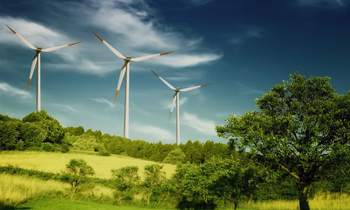
Energy
Energy development is a field of endeavor focused on making available sufficient primary energy sources and secondary energy forms to meet the needs of society]These endeavors encompass those which provide for the production of conventional, alternative and renewable sources of energy, and for the recovery and reuse of energy that would otherwise be wasted. Energy conservation and efficiency measures reduce the impact of energy development, and can have benefits to society with changes in economic cost and with changes in the environmental effects.
Contemporary industrial societies use primary and secondary energy sources for transportation and the production of many manufactured goods. Also, large industrial populations have various generation and delivery services for energy distribution and end-user utilization. This energy is used by people who can afford the cost to live under various climatic conditions through the use of heating, ventilation, and/or air conditioning. Level of use of external energy sources differs across societies, along with the convenience, levels of traffic congestion, pollution sources and availability of domestic energy sources.
Thousands of people in society are employed in the energy industry, of which subjectively influence and impact behaviors. The conventional industry comprises the petroleum industry the gas industry, the electrical power industry, the coal industry, and the nuclear power industry. New energy industries include the renewable energy industry, comprising alternative and sustainable manufacture, distribution, and sale of alternative fuels. While there is the development of new hydrocarbon sources including deepwater/horizontal drilling and fracking, are contentiously underway, commitments to mitigate climate change are driving efforts to develop sources of alternative and renewable energy.
Colloquially, and in non-scientific literature, the terms power, fuels and energy can be used as synonyms but in the field of energy technology they possess different distinct meanings that are associated with them. An energy source is usually in the form of a closed system, the element that provides the energy by conversion from another energy form; However, the energy can be quantitative, the balance sheet is capable of containing open system energy transfers. Illustrative of this can be the emanations from the sun, which with its nuclear fusion is the most important energy source for the Earth and which provides its energy in the form of radiation.
The natural elements of the material world exist in forms that can be converted into usable energy and are resources which society can obtained energy to produce heat, light, and motion (among the many uses).
According to their nature, the power plants can be classified into:
• Primary : They are found in nature: wind, water, solar, wood, coal, oil, nuclear.
• Secondary : Are those obtained from primary energy sources: electricity, gas.
Classified according to the energy reserves of the energy source used and the regeneration capacity with:
• renewable: When the energy source used is freely regenerated in a short period and there are practically limitless reserves; An example is the solar energy that is the source of energy from the sun, or the wind used as an energy resource. Renewable energies are:
• original solar
• natural wind (atmospheric flows)
• natural geothermal
• oceanic tidal
• natural waterfall (hydraulic flows)
• natural plant: paper, wood
• natural animal: wax, grease, pack animals and sources of mechanical energy
• nonrenewable: They are coming from energy limited sources on Earth in quantity and, therefore, are exhaustible. The non-renewable energy sources include, non-exclusively:
• fossil source: petroleum, natural gas, coal
• original mineral/chemical: uranium, shale gas
So, for example, shale gas is secondary non-renewable. Wind is a primary renewable.
The principle stated by Antoine Lavoisier on the conservation of matter applies to energy development: “nothing is created.” Thus any energy “production” is actually a recovery transformation of the forms of energy whose origin is that of the universe.
For example, a bicycle dynamo turns in part from the kinetic energy (speed energy) of the movement of the cyclist and converting it into electrical energy will transfer in particular to its lights producing light, that is to say light energy, via the heating of the filament of the bulb and therefore heat (thermal energy). But the kinetic energy of the rider is itself biochemical energy (the ATP muscle cells) derived from the chemical energy of sugars synthesized by plants who use light energy from the sun, which runs from the nuclear energy produced by fusion of atoms of hydrogen, the material itself constitute a form of energy, called “mass energy”.
Working with us or taking informaton keep in touch
You can fill the contact form or you can call to get information.



